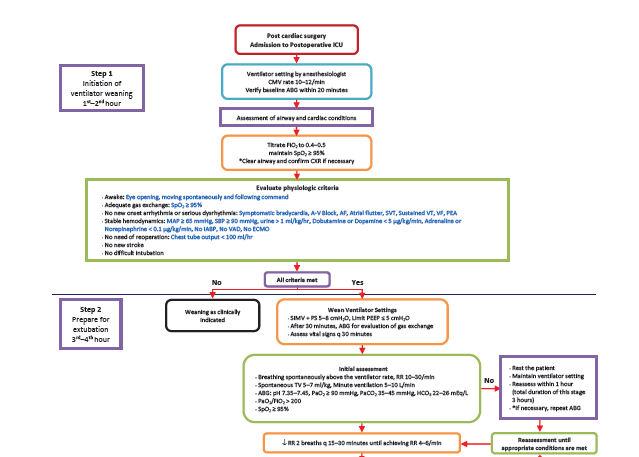Clinical Outcomes and Cost of Ventilator Weaning and Endotracheal Extubation Guided by An Established Ventilator Weaning Protocol in Patients Undergoing Elective Cardiac Surgery
DOI:
https://doi.org/10.33192/Smj.2021.106Keywords:
Early extubation, cardiac surgery, ventilator weaning protocol, complication, costAbstract
Objective: To compare successful early extubation rates, complications, and cost before and after the use of an
established ventilator weaning protocol in patients undergoing elective cardiac surgery.
Materials and Methods: Subjects were adult patients undergoing elective cardiac surgery who were clinically stable
within 2 hours after surgery. The control group underwent conventional ventilator weaning at the discretion of their
attending staff. The intervention group underwent protocol-guided ventilator weaning. The primary outcome was
a successful early extubation (within 6 hours after surgery). Secondary outcomes were complications from weaning
to 24 hours after surgery, and the relevant cost related to respiratory and cardiovascular care within 24 hours after
admission to the postoperative intensive care unit.
Results: The primary outcome occurred in 37 out of 65 patients (56.9%) in the intervention group and in 5 out of
65 patients (7.7%) in the control group (adjusted odds ratio 20.6; 95% confidence interval 6.7–62.9, p<0.001). The
complication rates were not statistically different between the intervention and control groups (26.2% vs. 20.0%,
p=0.41). The relevant cost, approximated by the service charges, related to respiratory and cardiovascular care was
significantly less in the intervention group than in the control group (median 2,491 vs. 2,711 Thai baht, p<0.001).
Conclusion: The use of the established ventilator weaning protocol after elective cardiac surgery was associated with
a higher rate of successful early extubation and lower cost related to respiratory and cardiovascular care compared
to the conventional practices of ventilator weaning and extubation. The rates of overall complications were not
significantly different.
References
A, et al. Prolonged mechanical ventilation after cardiac surgery:
outcome and predictors. J Thorac Cardiovasc Surg 2009;138:948–
53.
2. Zochios V, Chandan JS, Schultz MJ, Morris AC, Parhar KK,
Giménez-Milà M, et al. The effects of escalation of respiratory
support and prolonged invasive ventilation on outcomes of
cardiac surgical patients: a retrospective cohort study. J
Cardiothorac Vasc Anesth 2020;34:1226–34.
3. Guller U, Anstrom KJ, Holman WL, Allman RM, Sansom M,
Peterson ED. Outcomes of early extubation after bypass surgery
in the elderly. Ann Thorac Surg 2004;77:781–8.
4. Amirghofran AA, Rayatpisheh M, Rayatpisheh S, Kaviani M.
A comparative study of immediate and late extubation after
open heart surgery. Iran Cardiovasc Res J 2007;1:42–7.
5. Cheng DC, Karski J, Peniston C, Raveendran G, Asokumar B,
Carroll J, et al. Early tracheal extubation after coronary artery bypass
graft surgery reduces costs and improves resource use. a prospective,
randomized, controlled trial. Anesthesiology 1996;85:1300–10.
6. Reis J, Mota JC, Ponce P, Costa-Pereira A, Guerreiro M. Early
extubation does not increase complication rates after coronary
artery bypass graft surgery with cardiopulmonary bypass. Eur
J Cardiothorac Surg 2002;21:1026–30.
7. Litmathe J, Boeken U, Kurt M, Feindt P, Gams E. CABGprocedures
in patients with advanced age: early extubation
and fast track management as an option? The Cardiol 2008;4:7–10.
8. Camp SL, Stamou SC, Stiegel RM, Reames MK, Skipper ER,
Madjarov J, et al. Quality improvement program increases early
tracheal extubation rate and decreases pulmonary complications
and resource utilization after cardiac surgery. J Card Surg
2009;24:414–23.
9. Holowachuk S, Zhang W, Gandhi SK, Anis AH, Potts JE, Harris
KC. Cost savings analysis of early extubation following congenital
heart surgery. Pediatr Cardiol 2019;40:138–46.
10. Piotto RF, Maia LN, Machado MN, Orrico SP. Effects of the
use of mechanical ventilation weaning protocol in the Coronary
Care Unit: randomized study. Rev Bras Cir Cardiovasc
2011;26:213–21.
11. Chan JL, Miller JG, Murphy M, Greenberg A, Iraola M, Horvath
KA. A Multidisciplinary protocol-driven approach to improve
extubation times after cardiac surgery. Ann Thorac Surg 2018;
105:1684–90.
12. Serena G, Corredor C, Fletcher N, Sanfilippo F. Implementation
of a nurse-led protocol for early extubation after cardiac surgery:
a pilot study. World J Crit Care Med 2019;8:28–35.
13. Chan PK, Fischer S, Stewart TE, Hallett DC, Hynes-Gay P,
Lapinsky SE, et al. Practising evidence-based medicine: the
design and implementation of a multidisciplinary team-driven
extubation protocol. Crit Care 2001;5:349–54.
14. Ward D, Fulbrook P. Nursing strategies for effective weaning
of the critically ill mechanically ventilated patient. Crit Care
Nurs Clin North Am 2016;28:499–512.
15. Danckers M, Grosu H., Jean R, Cruz RB, Fidellaga A, Han Q, et. al.
Nurse-driven, protocol-directed weaning from mechanical
ventilation improves clinical outcomes and is well accepted
by intensive care unit physicians. J Crit Care 2013;28:433–41.
16. Society of thoracic surgeons of Thailand [Internet]. Bangkok:
The society of thoracic surgeons of Thailand; 2021. Stats-2562;
[cited 2021 October 16]. Available from: https://thaists.org/
en/stat-2562/.

Published
How to Cite
Issue
Section
License
Authors who publish with this journal agree to the following conditions:
Copyright Transfer
In submitting a manuscript, the authors acknowledge that the work will become the copyrighted property of Siriraj Medical Journal upon publication.
License
Articles are licensed under a Creative Commons Attribution-NonCommercial-NoDerivatives 4.0 International License (CC BY-NC-ND 4.0). This license allows for the sharing of the work for non-commercial purposes with proper attribution to the authors and the journal. However, it does not permit modifications or the creation of derivative works.
Sharing and Access
Authors are encouraged to share their article on their personal or institutional websites and through other non-commercial platforms. Doing so can increase readership and citations.














